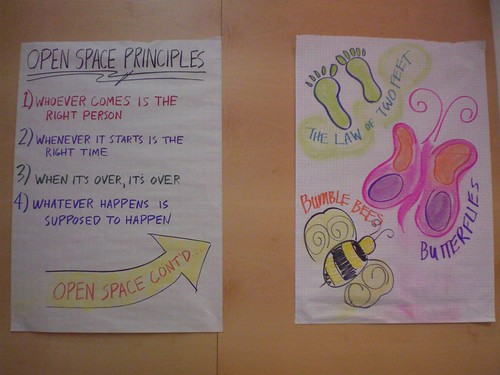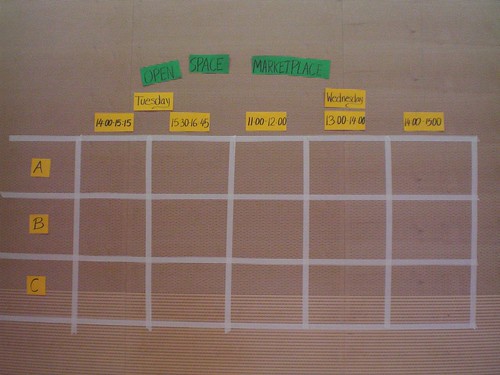 The Open Space started with introductions to the day and its focus on climate change related issues. Once this was done, Nadia and I explained the four principles of Open Space, law of the two feet and started with explaining the process of agenda creation.
The Open Space started with introductions to the day and its focus on climate change related issues. Once this was done, Nadia and I explained the four principles of Open Space, law of the two feet and started with explaining the process of agenda creation. To ensure that the 55 or so participants would understand the process of creating the agenda, where they are asked to write topics/issues/ideas that they wish to discuss on a piece of paper and put it on the board, we had planned that two of the organizers of the event will enact and start the process. Once they started, people started coming one by one to post their ideas on the agenda. During this process, there was also discussion about overlapping topics and possible merging of sessions. This was then carried into negotiation phase which allowed participants to reorganise the agenda further. The negotiation process is crucial because it helps clarify the real issue and understand better the idea of the convener in calling for that session.
To ensure that the 55 or so participants would understand the process of creating the agenda, where they are asked to write topics/issues/ideas that they wish to discuss on a piece of paper and put it on the board, we had planned that two of the organizers of the event will enact and start the process. Once they started, people started coming one by one to post their ideas on the agenda. During this process, there was also discussion about overlapping topics and possible merging of sessions. This was then carried into negotiation phase which allowed participants to reorganise the agenda further. The negotiation process is crucial because it helps clarify the real issue and understand better the idea of the convener in calling for that session.At the end of the day, we did a quick debrief on the outcomes of the day as well as the thoughts of the participants on the new, informal process.
Here are some of the key lessons learned in terms of what worked well.
- Organization: The event was well organised and kept flexible, in the spirit of informality of the method, so that participants could decide at last moment if they wish to participate. Everyone across the organization was well informed ahead of time and participants were sent an introductory flyer on how an open space works.
- Agenda: The process of agenda creation went in a very positive manner with participants actively contributing broad variety of important topics. One the agenda was relatively final, it was typed out and handed out to participants. This worked extremely well!
- Documentation of outputs: The outputs were all documented using a closed Google Blog.
- Method: The participants appreciated the opportunity to meet other colleagues from across the organization working on same or similar issues. The external participants benefited even because they could meet large number of people working on climate change from different aspects.
- Organization: The participants were asked to prepare their questions/topics for the open space ahead of time, however, this may not have worked well enough due to lack of knowledge about the method (and how it would require them to actively participate in agenda creation process). Additionally, because the event was located in a room where organisers were not allowed to bring any food, there were no coffee breaks. This is something that is critical to ensure that the conversations continue in an informal format outside the sessions and that people build connections.
- Agenda: The participants felt that they did not have enough time to negotiate the topics. As negotiation is an important step in using OS methodology, it should be allocated sufficient time. Additionally, some of the topics were grouped together in haste, without really understanding the clear overlaps in the topics. This resulted in sessions with more than one convener and time being spent on trying to figure out the common thread. As there were also too many parallel sessions, the participants sometimes were spread too thin. It might be useful in the future to aim for a group size of at least 6-8 per session.
- Documentation of outputs: Inserting reports in a blog took a lot of time because half of the reports were delivered in handwritten format due to lack of sufficient laptops. In future similar sessions, participants should be asked to bring their laptops or it should be provided in each room to ensure timely and efficient recording of results. One idea for next session could be to use Wikis which can be collaboratively edited by multiple people, further distributing the task of reporting.
- Process: Some sessions were well facilitated, others were not. It is important to brief the conveners before breaking out about their role. Conveners should also be asked to either facilitate or report and not try to do both! If the convener wants to facilitate, s/he should ask for a volunteer reporter.
- Method: Some participants felt that although the method was informal, the reporting of the method was very formalized (a template was provided to capture future action items, who will work on them, by when they will be delivered, etc.).
I would like to thank the climate change study circle organisers, Claudia Hiepe and Marja Liisa TapioBistrom, for inviting me and allowing me to be part of this exciting experience and development! The event ended on a positive note, I hope this is just the start!
2 comments:
Great work. Congratulations.
Reading this I had a thought about KS in the org, that might be worth more though... In this case the organization has both a formal, high level group for KS on climate change, and the informal CC Study Circle. Is there anything in this "parallel" existence of 2 groups that leads to more successful KS? It might be a good model for the organization.
Thanks Michael for your feedback. The commonality between the formal/informal is that the formal one is lead by the same person who "supports/encourages" the informal study circle. Else, there is very small overlap between the two because in case of the formal structure people are nominated whereas in the informal one anyone interested in the issue of climate change can participate. This participation can range from top management and technical officers to newly arrived volunteers or consultants from any part of the organization.
We need more of these informal cross-organizational-structure communities to flourish to improve level and flow of knowledge within the organization, especially in areas such as climate change, biofuels, etc. These, however, will need to be supported/encouraged by the management. Often management is needed, in our setting, to support initiatives such as the Open Space.
Post a Comment